
No matter how careful you are to provide the highest-quality products and the best customer experience, returns are a fact of life in eCommerce. Even if your store policy completely forbids the return of any orders, you're still going to have situations where customers at least want to make a return and inquire about it. You're going to need a system in place to handle returns no matter what.
To approach returns effectively, you need not only the right tools, but the right attitude. This includes understanding why customers return products and how to use a return as an opportunity to win over a customer who may seem dissatisfied. The way you handle returns will also affect your business operations in other ways, so you can make it easier on yourself by doing it properly — or harder, if you don't.
In this guide, we'll cover everything about returns and how to process them, so you'll be fully prepared to handle them in the best possible way.
Why do Customers Return Products?
Before you can process returns effectively, you need to understand why they happen. There are tons of reasons why customers return their purchases, but they can be summed up into general categories:
- The customer changed their mind.
- The customer made a mistake.
- The merchant made a mistake.
- The product arrived in unusable condition.
- The customer is committing fraud against the merchant.
Let's go over these, one by one.
The Customer Changed Their Mind
There isn't much you can do about customers changing their minds — one of the risks of eCommerce is that a customer's opinion of a product might change as soon as they get it in their hands. This is a side effect of the fact that shopping online means the customer can't inspect the product in person.
The Customer Made a Mistake
This is when a customer orders the wrong product for their needs, or even orders something by accident. Customer mistakes can be the customer's fault, i.e. if they weren't paying attention or failed to read important information that would help them choose the right product. However, customer mistakes can also be your fault, if your website is confusing, your checkout is buggy, or you have poor product information.
The Merchant Made a Mistake
Packing and shipping the wrong product is a fairly common occurrence, but still reflects poorly on a business. Sending the wrong item makes you look sloppy at best, and this type of issue can cost you more than other refund situations because your customer is actually under no obligation to return the product at all. That's right: FTC guidelines state that you cannot charge customers for anything they didn't order, so if you send them the wrong product, you need to refund them and allow them to keep the item too! So, while technically this isn't a "return," as the customer doesn't need to return the item, it will still involve a refund which you'd handle through the same process.
The Product Arrived in Unusable Condition
Sometimes bad things happen during shipping, and orders get broken before they arrive. At least in this situation the fault usually lies with the shipping carrier, but your packaging may not be sufficient to prevent breakage.
The Customer Is Committing Fraud Against the Merchant
If you spend any time in online communities devoted to eCommerce, especially among those using platforms like eBay, it won't be long before you hear a horror story of a dishonest customer receiving a refund and returning a broken or used product, a completely different item, or even a box of rocks. Fortunately, outright fraud is harder for a dishonest customer to pull off on an independently owned online store (as opposed to a marketplace with its own policies) and the right tools can help further prevent it.
By dividing up customers' reasons for returns into these categories, we can simplify one of the complexities of eCommerce — the individual situations of all customers and orders — into a few distinct issues, each of which can be addressed in their own way. It's important to understand each type of return so you can tailor your policy accordingly, and even help prevent them from happening.
How to Reduce Returns
The first step to an efficient returns process is to reduce the number of returns you need to process in the first place. This will reduce your workload, and if you approach returns mitigation correctly, it will have the side effect of improving your business's reputation and customer satisfaction. Let's look at the wrong way and the right way to reduce returns:
The wrong way is to simply crack down on return restrictions for your customers. Of course, in the case of some products, you already need strict return guidelines or may not be able to accept them at all. We're not saying every return policy needs to be the same, but unless your products have specific qualities that make them impossible to return, a harsh return policy isn't going to solve problems that stem from your online store itself. For example, if customers keep mistakenly ordering a certain product and returning it, you're only doing a disservice to both them and yourself if you try to stop them by restricting returns on that product. Instead, the real problem might be that your product pages are confusing your customers and causing them to make this mistake.
That brings us to the right way to reduce returns: by eliminating as many opportunities as possible for customers to get confused or make the wrong purchase, and by improving your packing and shipping procedures to ensure customers receive the correct orders in perfect condition. This means addressing each of the major return reason categories.
Great product information and photos will help customers have a better idea of what they're buying, which helps eliminate mistakes on their part by helping them choose the correct item the first time. This can also cut down on customers who change their minds, since they'll be better able to imagine themselves using the product before they buy it.
Merchant mistakes, and shipping damage, can be reduced by evaluating and improving your pick, pack, and ship procedure. If your business keeps making the same mistakes, you can use this information to help you identify exactly where the problems are; for example, if a specific item always gets shipped instead of another, you need to make it easier for your staff to distinguish between the two. If the same product always gets broken in transit, you need to come up with a reliable packaging solution that will allow that item to survive the journey.
As for customer fraud, the most frustrating aspect of it is that you can't force customers to be honest. Instead, you'll need to take steps to defend yourself — for example, by not issuing refunds until after a return has been approved and arrived in satisfactory condition. You'll also need to have a strong policy and good record-keeping in place to fight against chargebacks if needed.
In addition to protecting your business, your return policy will also be at the core of your entire returns procedure, so it's crucial to set one up.
Setting Up a Return Policy
Smaller eCommerce businesses often overlook the need for a return policy because they don't think they'll ever have to deal with so many returns that they can't handle them on a case-by-case basis by working it out with the customer. Other times, the business just isn't yet sure how it wants to handle returns or what its policies could be, and fears making a mistake that could harm their early growth.
However, the biggest mistake is not to have a return policy at all. Lack of a written policy leads to inconsistent return management that can end up angering customers. It can also cause unnecessary loss of profits, and make you appear disorganized, which can lead to customers leaving whether or not they had a bad experience. Additionally, handling returns without a set policy simply takes too much work. Think of it this way: you're starting from nothing, every single time.
A thoroughly written return policy will:
- Serve as the foundation for handling every return.
- Give customers consistent expectations.
- Reduce returns by eliminating those that are outside your policy.
- Save time and money for your business.
Of course, a return policy is no good if customers can't understand it, or if it's so long and complex that they can barely read it. It's your responsibility to write a return policy that is simple enough to understand easily but detailed enough to cover the needed points. Fortunately, it's not too hard to learn how to write a great return policy. You'll need to include the following:
- Time limits. Be clear on how long your customers have to return a product, and use numbers. Saying "30 days" is clearer than saying "one month," since months vary in length.
- Acceptable condition and other requirements. Some businesses have made a name for themselves by accepting returns "no questions asked," but if you can't take a return if the product is no longer salable, make note of it. For example, your returns may require the product to be unused and with all original packaging.
- How the customer will receive their refund (and how soon). Can you simply put the money back on the customer's credit card or will you issue them store credit instead? How long does this take?
- Related fees. Will the customer need to pay shipping for their return or do you handle it? Are there any other costs involved for them, like a restocking fee?
- Any exceptions. Do some of your products have different return requirements than others? Make sure these are explained on your policy page as well as mentioned on the applicable product pages.
- The exact procedure. This describes how customers will initiate the return, how long the process takes, and so on. This is partially determined by your RMA system, which we'll cover shortly.
Once your return policy is written, it needs to be easily available on your website. Shift4Shop allows you to create unlimited website pages, so you can make a page for your Return Policy and link it in your website's footer, allowing access from all other pages on your site. Following our guidelines should make it relatively easy to write your return policy, but if you're having problems, you can start with a free return policy generator to create a template you can work from.
Opportunities When Processing Returns
Smart business owners know that a return is never a disaster. It's an opportunity to win the customer over once and for all by impressing them with how you handle the situation. Philosophically minded people often say that you only learn the true measure of a person when something has gone wrong, and the same is true for businesses.
When you get a return request, it's a chance to build customer loyalty. You do this by showing understanding to your customers and demonstrating that you truly value them and care about their experience with your business. Show them that you have their best interests at heart, and that you want them to be happy with your products — even if that means completely returning the item they bought and getting their money back.
Customers will remember how well you served them. Despite the fact that they returned a product, by providing a great return experience, you'll make the customer remember how easy the return was and how much you care about them. This will make them much more likely to buy again from you in the future. After all, they know that if something goes wrong, you'll help!
The opposite is true, too: if you're rude or dismissive during the returns process, you're telling the customer that you only wanted their money and are angry that you had to help them. It should be obvious that this is going to drive them away forever.
Of course, we're not saying that you should accept every return, no matter how unreasonable. Remember that this is why you need a return policy: to tell your customers the exact circumstances under which you'll accept a return, and how the process will work. It's up to you how flexible you are with your return policy and how much freedom you give your customers when they want to return a purchase.
Why Handling Returns Properly Matters
Always handle returns in accordance with your policy. This will help your store appear honest, trustworthy, and consistent. These are all crucial for building the loyal customer base that will help your business thrive. Sticking to your return policy will also make it easier to provide customer service, as it works as a standard procedure for you and your employees to follow.
What happens to the returned items once they come back to you is just as important as the return process itself. Be organized when receiving returns. This will ensure your inventory remains consistent, as you'll be able to restock salable return items and keep your accounting straight.
Overall, correct handling of returns is good for both your business and your customers. You can use an RMA system to help make the return process smooth.
What is an RMA System and Why Do You Need It?
RMA stands for Return Merchandise Authorization. An RMA system is a software solution that provides a set of tools for handling returns in an organized manner. This includes tools that help you enforce the rules of your return policy and to streamline the process altogether.
An RMA system allows you to review a customer's return beforehand and choose to accept or reject it — hence the authorization. You can use it to collect information from the customer that will help you choose whether the return is acceptable. The RMA also has tools for receiving the return back into your inventory and dispersing the refund, store credit, or replacement item to the customer. RMA systems also help with recordkeeping, which helps avoid disputes or chargebacks.
On the customer-facing side, an RMA system gives shoppers an obvious way to start the returns process rather than needing to contact you. Having an easy feature for initiating a return will increase customer confidence, as they'll know before they buy that the option is available.
An RMA system can be a central part of your return policy, as you can require all returns to come through the RMA. It can also be used to enforce the policy by having certain limitations coded into it, such as your timeframe and acceptable reasons for the return.
While many types of RMA software are available, Shift4Shop comes with a built-in module that lets you start using this essential feature right away, with no need to use a third-party solution. Let's take a look at how it works.
How to Set Up the Shift4Shop RMA Module
Setting up the Shift4Shop RMA module only takes a few minutes. Have a copy of your store's return policy handy to make sure you set the options consistently, and log into your Shift4Shop Online Store Manager. Navigate to Modules and locate the RMA module — you can do this easily by typing Return into the Search bar. If the module is available in your plan, click the Enable checkbox to turn it on, and then click Save in the upper right corner.
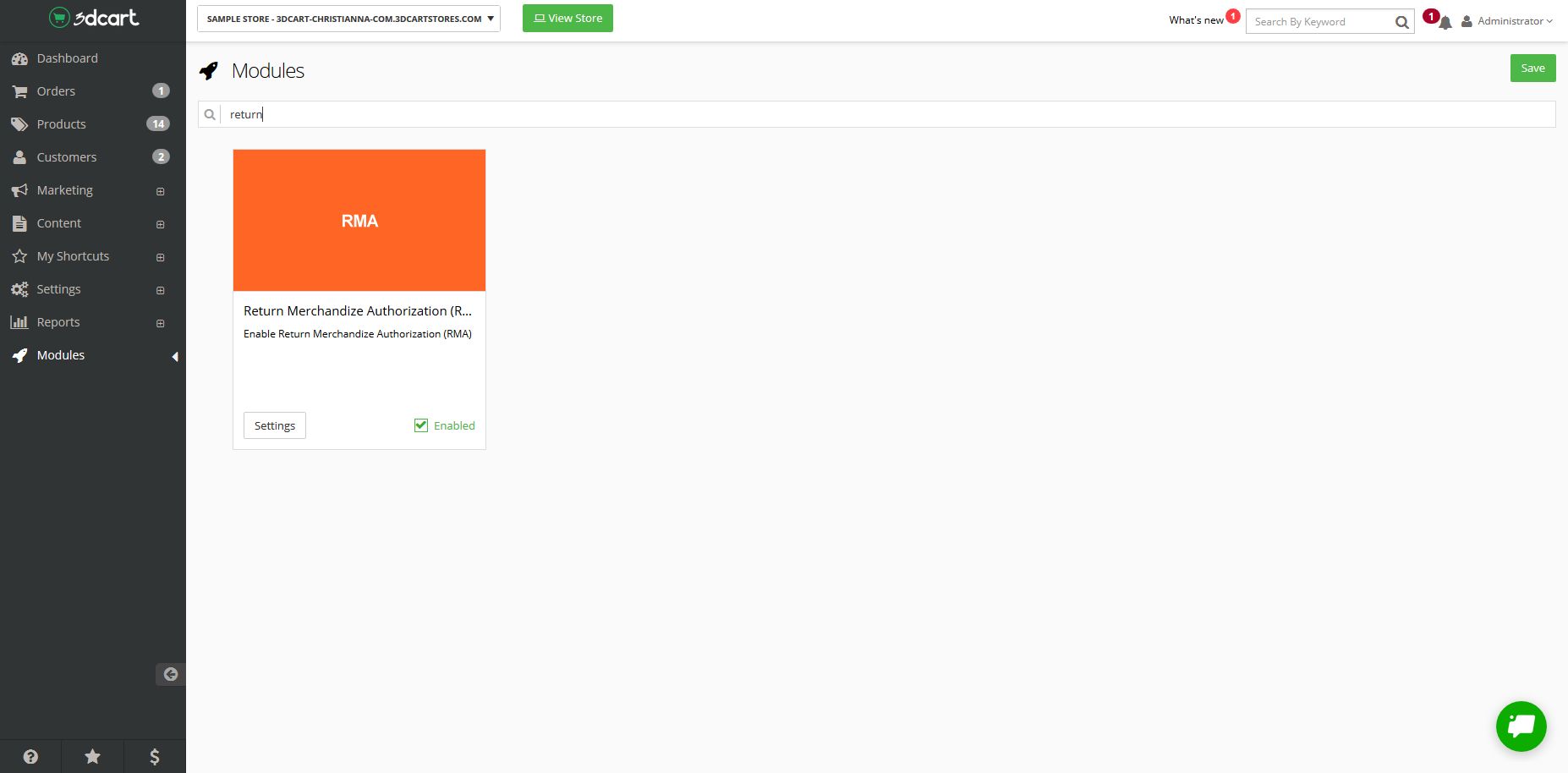
Next, click the module's Settings button to bring up a window containing a field labeled RMA Max Period (days). This is the global setting, for your entire store, that decides the maximum number of days that can elapse before an order becomes ineligible for an RMA. Consider this the default setting — if you want different time periods on different items, you can set those on each product's Advanced tab.
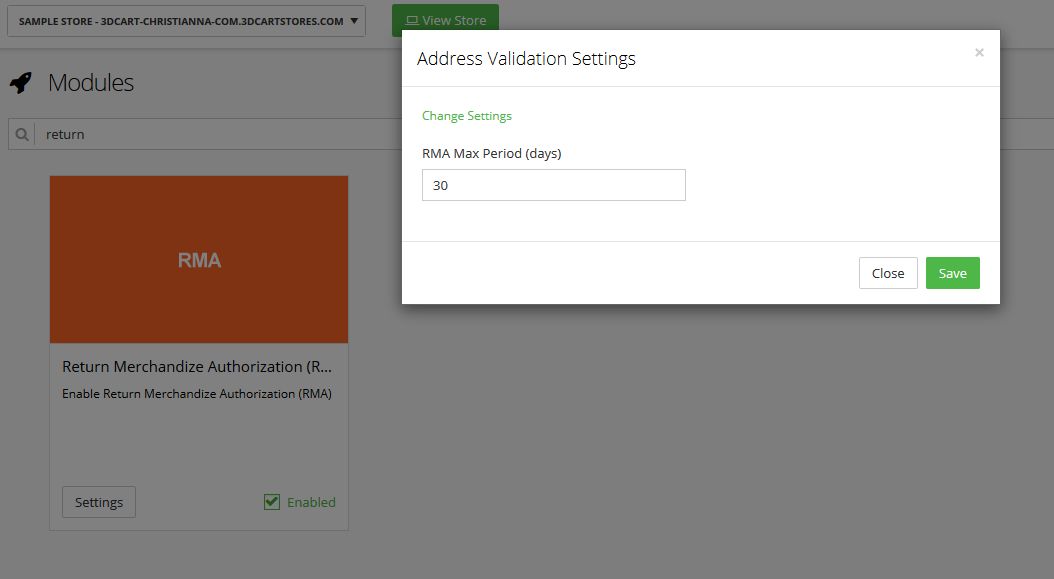
After enabling the module and entering your desired default maximum return period, you'll need to configure more advanced settings. You'll find these by clicking Change Settings above the RMA Max Period (days) field. These settings include:
- Methods: These are the methods for refunding your customer.
- Reasons: These are the reasons a customer can select for making the return.
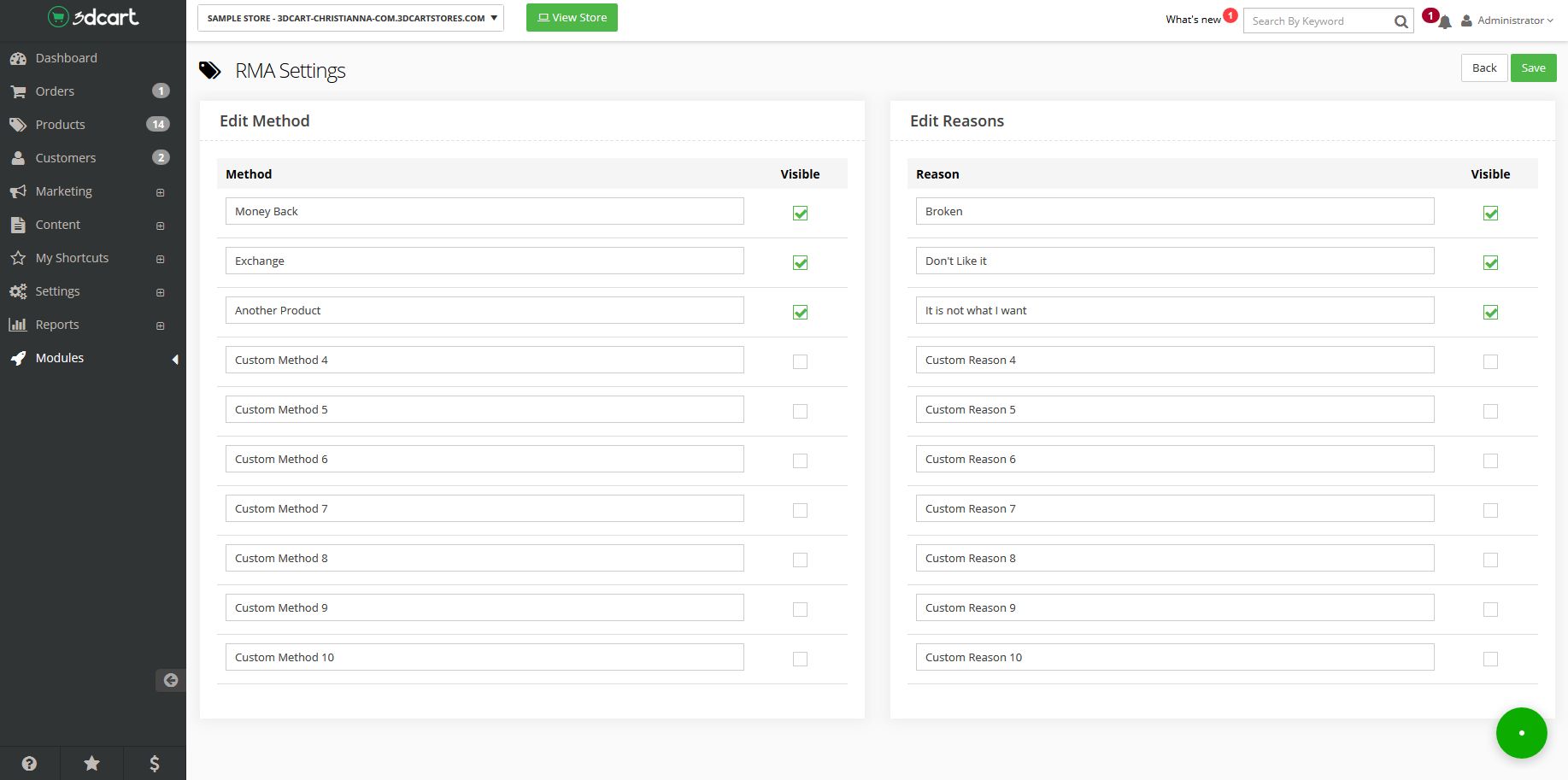
Both Methods and Reasons have some premade options you can edit or hide as needed. You can also create additional ones. Just make sure the Visible checkbox is selected so the customer will be able to see it. You should set up the Methods and Reasons based on the policies and needs of your store. For example, if you only want to offer store credit, gift certificates, and exchanges, but no direct refunds, ensure your Methods settings reflect this.
Starting the Return Procedure with the RMA
Once the RMA is set up and configured, it's ready to use for processing returns. When an RMA is initiated, you'll use the system to communicate with the customer and authorize or reject the return, or request more information. There are two ways an RMA can be initiated.
RMA Initiated by the Customer
This is when the customer decides they want to return an item. They can start an RMA from their My Account page on your store, where they can see their customer record. All their orders will be listed, and they can select the right one and click Add New RMA. The RMA form will appear, and they'll need to select their Reasons and Methods for the return. They can also add comments to provide further explanation.
The Shift4Shop RMA also includes a File Upload feature which allows customers to add an image or other file to their RMA request, which is great for giving you a chance to assess the condition of the item before you accept the return. While working on an RMA request, you can also upload files as well, if you should need to.
Once the customer is done filling out the RMA, they can click Save RMA and a confirmation email will be sent out to both you and the customer. You can customize this email by editing the template called RMA - New RMA – Customer which can be found in the Settings > Design > Emails section of your Shift4Shop Online Store Manager.

RMA Initiated by the Merchant
There may be some cases where you or an employee might want to initiate an RMA yourself. This can happen if you need to recall a certain item or perform customer service by starting the returns process for them. In this case, you'd navigate to Orders and then Manage Orders. Click the invoice number of the order in question, then click the Actions button at the top right and select New RMA. From there, you'll see a similar form with selectable Methods and Reasons.
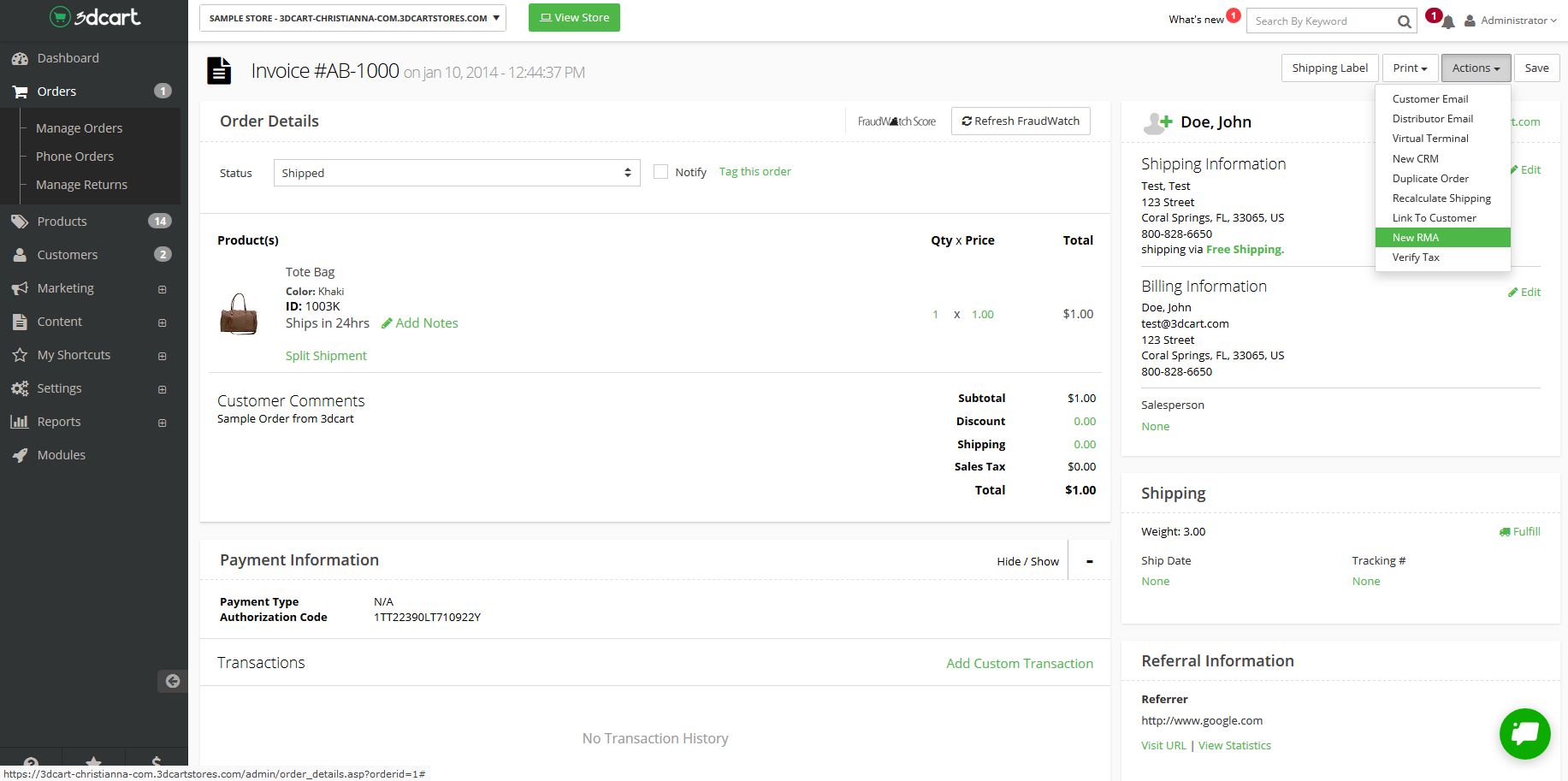
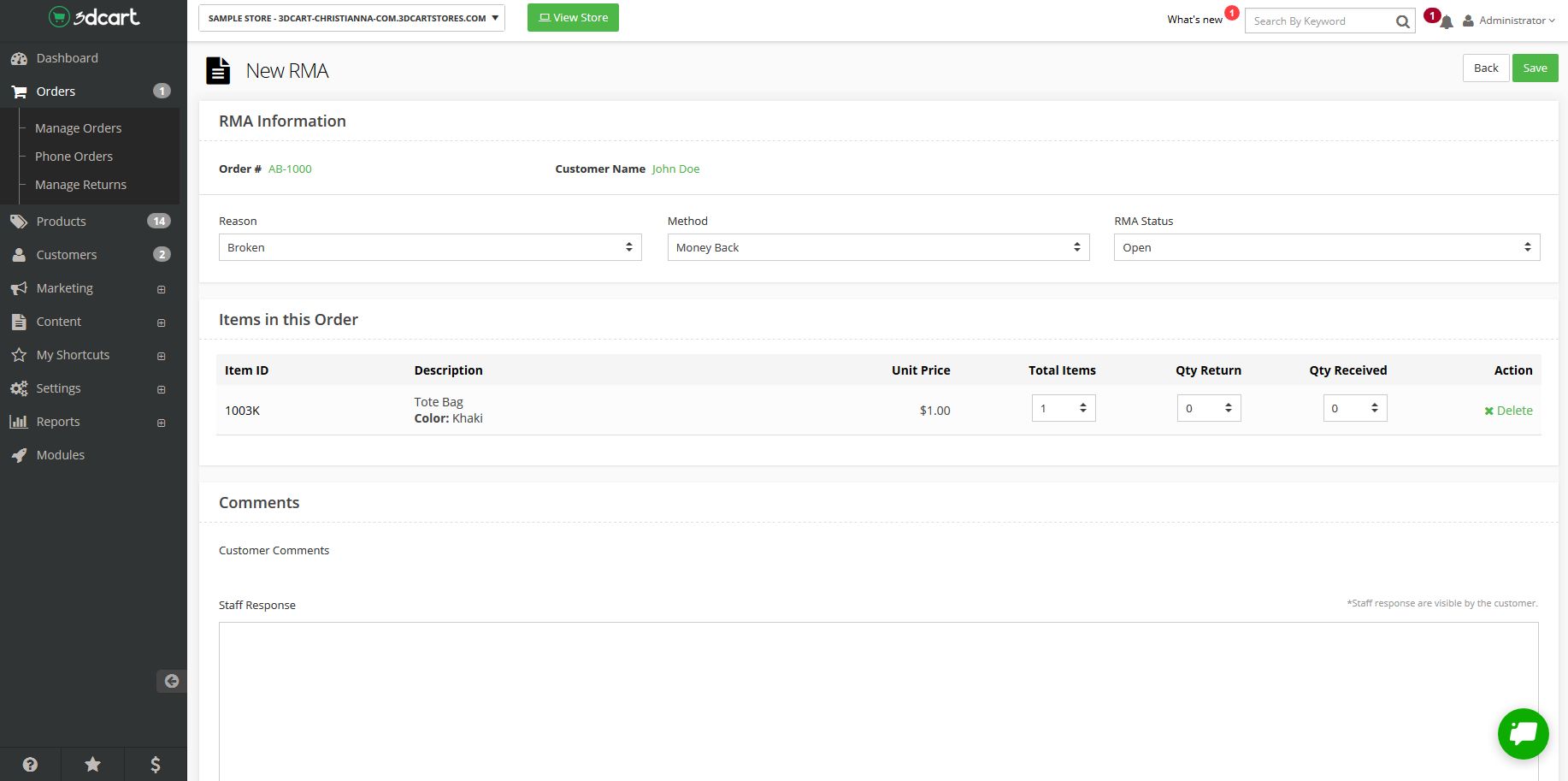
If you scroll down, you'll see that there are two places you can leave comments on the RMA: a staff response which will be visible to the customer, and internal comments visible only to your employees. Use these sections to send notes with the RMA to the customer and/or your employees as needed. Scrolling down also brings you to the section that contains any uploaded files.
Once you're done, save the RMA, and reach out to your customer to let them know it's been created. Merchant-initiated RMAs don't automatically email the customer.
Processing the Return with the RMA
You can find and process all open RMAs by visiting Orders and then Manage Returns. Click on the RMA number for the RMA you want to process.
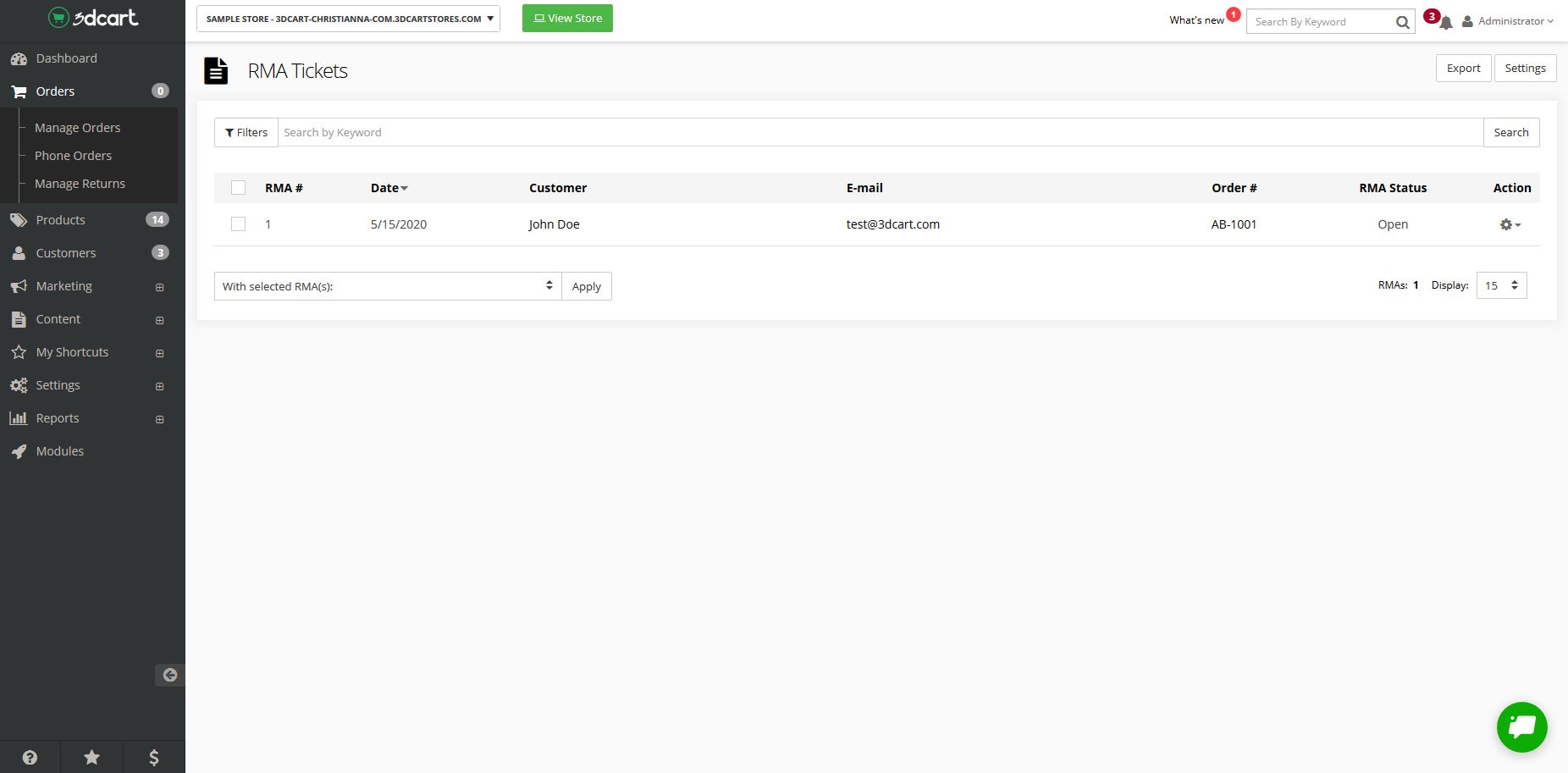
This is the step in which you read over the information the customer has provided and decide whether or not to authorize the return. The staff response and internal comment boxes are available so you can leave a message for the customer and/or for your employees.
If you decide to accept the return, click the button labeled More and choose Send the RMA Instructions Email. This sends an email to the customer with the next steps for proceeding with their return. You can customize this email as well; it's found in the same Settings > Design > Emails section and the name of the template is RMA - RMA Authorization Instructions.
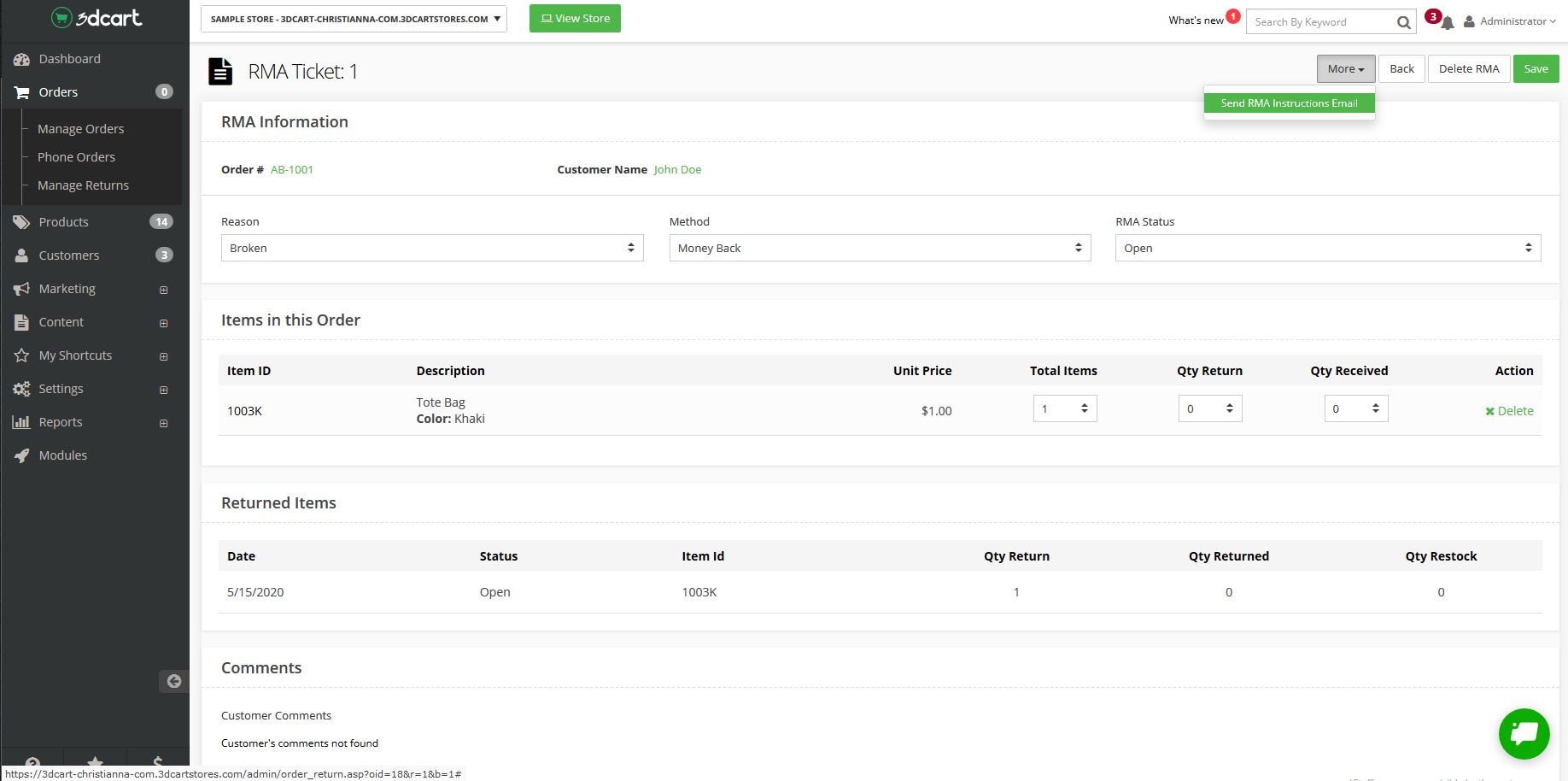
While you work on the RMA, change its status to Processing in the Order Return Options section and leave it there until the situation is completely resolved. Don't forget to save the RMA to preserve your changes.
Printing Return Shipping Labels from the RMA
If you want to provide free return shipping, you can make the returns process even easier for your customers by generating a return label for them to use. The return labels you create will automatically have your business's address as the recipient and the customer's as the sender — the same information from your shipping label, but reversed. This label can be emailed to the customer for them to print out and use.
If your store meets the requirements (Shift4Shop version 9.1 or higher), the option to Create Return Label will be found in the menu with the Send the RMA Instructions Email option. Shift4Shop is fully integrated with FedEx to provide RMA labels, and you'll need to use FedEx Real-Time Shipping Calculation to use this feature out of the box, but you can manually set it up to work with other shipping carriers.
Resolving and Closing the RMA
Once you receive the returned item, find the RMA by clicking its number within Orders > Manage Returns. The RMA allows you to define how many of an item you received as well as how many are to be restocked into your inventory, which may not be the same number if you agreed to receive a return of an unsalable item. In the Order Items section, select the applicable amounts from the Qty. Received and Qty. Restock dropdowns. The number you select for Qty. Restock will automatically update your store's inventory with the returned item. If you're not restocking any of the received items, choose 0.
To close the RMA, write any additional comments to the customer in the staff comments section and move the RMA Status to Closed in the Order Return Options section, and save your changes. Make sure you're ready to close the RMA for good before you set it to Closed, as neither you nor the customer will be able to reopen or modify it.
You can close an RMA at any time, regardless of how much of the process has been followed, so you can deny RMAs in the same fashion. Just be sure to leave comments for the customer as to why you're not honoring the RMA.
Refunding the Customer
The RMA system is meant for tracking and managing returns and does not connect to your payment provider, so you'll need to initiate the refund manually once you reach that point in the process. If you're providing an exchange product, store credit, or a gift certificate rather than a straight refund, you'll likewise need to take care of this step yourself.
Wrapping Up
Returns are just like any other part of eCommerce (or business in general): made much easier with the right tools. Shift4Shop's RMA system is built to help you process them faster and keep your customers happier — and your profits higher.
However, tools alone can't make up for a well-thought-out return policy and exemplary customer service. Your actions and choices as a business owner will have the most impact on how returns affect your store, and whether they'll have potential to gain you new customers, or lose them. Just remember that returns are an opportunity to provide the type of great customer experience that builds lifelong loyalty to a brand.





Leave a reply or comment below